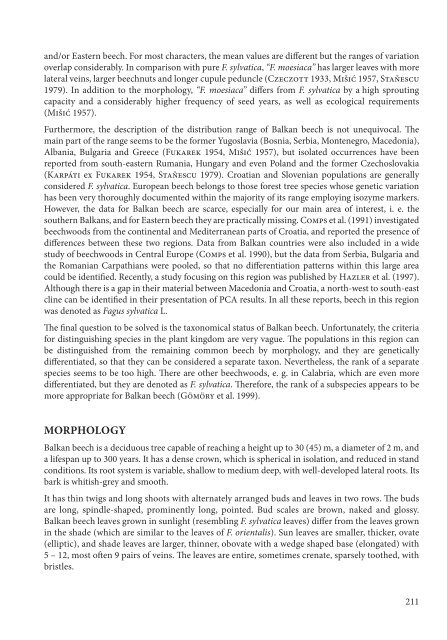You also want an ePaper? Increase the reach of your titles
YUMPU automatically turns print PDFs into web optimized ePapers that Google loves.
and/or Eastern beech. For most characters, the mean values are different but the ranges of variation<br />
overlap consi<strong>de</strong>rably. In comparison with pure F. sylvatica, “F. moesiaca” has larger leaves with more<br />
lateral veins, larger beechnuts and longer cupule peduncle (Czeczott 1933, Mišić 195 , Staňescu<br />
19 9). In addition to the morphology, “F. moesiaca” differs from F. sylvatica by a high sprouting<br />
capacity and a consi<strong>de</strong>rably higher frequency of seed years, as well as ecological requirements<br />
(Mišić 195 ).<br />
Furthermore, the <strong>de</strong>scription of the distribution range of Balkan beech is not unequivocal. The<br />
main part of the range seems to be the former Yugoslavia (Bosnia, Serbia, Montenegro, Macedonia),<br />
Albania, Bulgaria and Greece (Fukarek 1954, Mišić 195 ), but isolated occurrences have been<br />
reported from south-eastern Rumania, Hungary and even Poland and the former Czechoslovakia<br />
(Karpáti ex Fukarek 1954, Staňescu 19 9). Croatian and Slovenian populations are generally<br />
consi<strong>de</strong>red F. sylvatica. European beech belongs to those forest tree species whose genetic variation<br />
has been very thoroughly documented within the majority of its range employing isozyme markers.<br />
However, the data for Balkan beech are scarce, especially for our main area of interest, i. e. the<br />
southern Balkans, and for Eastern beech they are practically missing. Comps et al. (1991) investigated<br />
beechwoods from the continental and Mediterranean parts of Croatia, and reported the presence of<br />
differences between these two regions. Data from Balkan countries were also inclu<strong>de</strong>d in a wi<strong>de</strong><br />
study of beechwoods in Central Europe (Comps et al. 1990), but the data from Serbia, Bulgaria and<br />
the Romanian Carpathians were pooled, so that no differentiation patterns within this large area<br />
could be i<strong>de</strong>ntified. Recently, a study focusing on this region was published by Hazler et al. (199 ).<br />
Although there is a gap in their material between Macedonia and Croatia, a north-west to south-east<br />
cline can be i<strong>de</strong>ntified in their presentation of PCA results. In all these reports, beech in this region<br />
was <strong>de</strong>noted as Fagus sylvatica L.<br />
The final question to be solved is the taxonomical status of Balkan beech. Unfortunately, the criteria<br />
for distinguishing species in the plant kingdom are very vague. The populations in this region can<br />
be distinguished from the remaining common beech by morphology, and they are genetically<br />
differentiated, so that they can be consi<strong>de</strong>red a separate taxon. Nevertheless, the rank of a separate<br />
species seems to be too high. There are other beechwoods, e. g. in Calabria, which are even more<br />
differentiated, but they are <strong>de</strong>noted as F. sylvatica. Therefore, the rank of a subspecies appears to be<br />
more appropriate for Balkan beech (Gömöry et al. 1999).<br />
morPhoLoGy<br />
Balkan beech is a <strong>de</strong>ciduous tree capable of reaching a height up to 30 (45) m, a diameter of 2 m, and<br />
a lifespan up to 300 years. It has a <strong>de</strong>nse crown, which is spherical in isolation, and reduced in stand<br />
conditions. Its root system is variable, shallow to medium <strong>de</strong>ep, with well-<strong>de</strong>veloped lateral roots. Its<br />
bark is whitish-grey and smooth.<br />
It has thin twigs and long shoots with alternately arranged buds and leaves in two rows. The buds<br />
are long, spindle-shaped, prominently long, pointed. Bud scales are brown, naked and glossy.<br />
Balkan beech leaves grown in sunlight (resembling F. sylvatica leaves) differ from the leaves grown<br />
in the sha<strong>de</strong> (which are similar to the leaves of F. orientalis). Sun leaves are smaller, thicker, ovate<br />
(elliptic), and sha<strong>de</strong> leaves are larger, thinner, obovate with a wedge shaped base (elongated) with<br />
5 – 12, most often 9 pairs of veins. The leaves are entire, sometimes crenate, sparsely toothed, with<br />
bristles.<br />
211

















